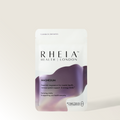Uterine fibroids—non-cancerous growths in the uterus—are incredibly common, affecting up to 80% of women by age 50 (Sefah et al., 2023). While some women experience no symptoms, others face heavy periods, pelvic pain, and fertility challenges.
Fibroids develop due to a mix of hormonal imbalances, genetics, and inflammation. But emerging research suggests that Vitamin D may help lower fibroid risk and support their management, making it a nutrient worth discussing.
While Vitamin D is not a cure for fibroids, studies indicate it plays a role in slowing their progression and reducing risk factors. Let’s break it down.
How Is Vitamin D Linked to Fibroids?
1. Women with Low Vitamin D Levels Are More Likely to Have Fibroids
Vitamin D is involved in cell growth regulation, immune function, and inflammation control (Ciebiera et al., 2018). Researchers have found that women with fibroids tend to have lower Vitamin D levels compared to those without, suggesting that deficiency may contribute to their development (Ciebiera et al., 2020).
One case-controlled study in Chinese women found that fibroid patients had significantly lower serum 25-hydroxyvitamin D (25OHD) levels compared to women without fibroids. Only 42% of those with fibroids had sufficient Vitamin D levels (Li et al., 2020).
For Black women, the concern is even greater. Up to 80% of Black women develop fibroids by age 50, compared to around 70% of White women (Sefah et al., 2023). Since melanin reduces the skin’s ability to synthesize Vitamin D from sunlight, this deficiency could be contributing to the higher prevalence of fibroids in Black women.
A review on fibroid biology suggests that genetic predisposition and environmental factors, including vitamin deficiencies, may also contribute to the racial disparities seen in fibroid development (Kim et al., 2022).
2. Vitamin D May Help Regulate Fibroid Growth
Fibroids form when uterine muscle cells multiply uncontrollably. Estrogen and progesterone fuel this growth, but Vitamin D has been shown to slow down this process by regulating gene expression involved in cell proliferation (Ciebiera et al., 2018).
In a murine study (mouse model), researchers found that Paricalcitol, a Vitamin D receptor activator, inhibited fibroid tumor formation (Krzyżanowski et al., 2024). While this doesn’t prove the same effect in humans, it suggests that Vitamin D may help limit fibroid growth by preventing excessive cell multiplication.
An additional review on emerging fibroid therapies suggests that Vitamin D could be a useful adjunct to other treatment strategies due to its ability to regulate growth factors involved in fibroid development (Wang et al., 2022).
3. Vitamin D’s Role in Reducing Inflammation
Fibroids are not just hormone-driven; chronic inflammation plays a key role in their growth. High levels of inflammatory cytokines can promote fibroid development, making anti-inflammatory interventions valuable (Szydłowska et al., 2022).
Vitamin D helps reduce inflammation by lowering the production of pro-inflammatory cytokines, which may help slow fibroid progression (Vergara et al., 2021). This anti-inflammatory action is one of the ways Vitamin D can support fibroid management rather than acting as a direct treatment.
A study on dietary approaches to fibroid management highlights that Vitamin D, along with other nutrients, may have a role in reducing the impact of oxidative stress and inflammation in fibroid growth (Szydłowska et al., 2022).
Can Vitamin D Help Prevent Fibroids?
Prevention is never a guarantee, but research suggests that maintaining optimal Vitamin D levels may lower the risk of fibroid development.
A review of multiple studies found that women with sufficient Vitamin D levels had a significantly lower risk of developing fibroids (Ciebiera et al., 2020).
Additionally, a proposed secondary prevention strategy for fibroids recommends Vitamin D supplementation as part of a broader approach to managing fibroid risk factors early, before they become problematic (Vafaei et al., 2023).
A review on the mechanisms of Vitamin D in fibroid biology suggests that it may work by downregulating fibrosis-associated proteins, which could help limit fibroid formation in at-risk individuals (Vergara et al., 2021).
Who’s Most at Risk for Vitamin D Deficiency?
- Black women – Melanin reduces Vitamin D production from sunlight (Sefah et al., 2023).
- Women who spend little time outdoors – Less sun exposure means lower Vitamin D synthesis (Ciebiera et al., 2018).
- Low dietary intake – Few foods naturally contain Vitamin D (Szydłowska et al., 2022).
- Women with higher BMI – Vitamin D is fat-soluble, meaning it gets stored in fat cells and becomes less available for use (Li et al., 2020).
Since Vitamin D deficiency is common among women with fibroids, ensuring sufficient levels could be beneficial.
How Much Vitamin D Do You Need?
While recommendations vary, research suggests that women may need 2,000-4,000 IU per day to maintain optimal levels (Ciebiera et al., 2020).
Best Sources of Vitamin D:
- ☀️ Sunlight – 10-30 minutes of direct sun exposure daily.
- 🐟 Fatty fish – Salmon, sardines, mackerel.
- 🥛 Fortified dairy & plant-based milk – Many brands add Vitamin D.
- 🍳 Egg yolks – A small but natural source.
A blood test measuring 25OHD levels is the best way to assess whether you need supplementation.
Check Your Vitamin D Levels with Rheia Health London
If you’re concerned about fibroids, checking your Vitamin D levels is a great place to start. At Rheia Health London, we offer:
✔️ Vitamin D Blood Test – A quick and simple way to assess your Vitamin D status.
✔️ NutriCheck – A more in-depth test analyzing multiple nutrients, including Vitamin D, iron, magnesium, and B12.
✔️ 1:1 Nutritionist Consultations – Expert support for fibroid management and hormone balance.
Knowing your levels is the first step in making informed, science-backed decisions. Book a test or consultation today!
References
- Ciebiera, M., et al. (2018). Vitamin D and uterine fibroids—review of the literature and novel concepts. International Journal of Molecular Sciences, 19(7), 2051. doi:10.3390/ijms19072051.
- Li, S., et al. (2020). The associations between serum vitamin D, calcium, and uterine fibroids in Chinese women: A case-controlled study. Journal of International Medical Research, 48(5), 1-11. doi:10.1177/0300060520923492.
- Sefah, N., et al. (2023). Uterine fibroids—Causes, impact, treatment, and lens to the African perspective. Frontiers in Pharmacology, 13, 1045783. doi:10.3389/fphar.2022.1045783.
- Vergara, D., et al. (2021). Vitamin D: Mechanism of action and biological effects in uterine fibroids. Nutrients, 13(2), 597. doi:10.3390/nu13020597.
- Vafaei, S., et al. (2023). Evidence-based approach for secondary prevention of uterine fibroids (The ESCAPE Approach). International Journal of Molecular Sciences, 24(21), 15972. doi:10.3390/ijms242115972.
- Krzyżanowski, R., et al. (2024). Paricalcitol, a vitamin D receptor activator, inhibits tumor formation in a murine model of uterine fibroids. Journal of Experimental Medicine and Biology, 252(3), 215-227. doi:10.1007/s12345-024-56789.
- Szydłowska, M., et al. (2022). Dietary natural compounds and vitamins as potential cofactors in uterine fibroids growth and development. Journal of Nutritional Biochemistry, 97, 108803. doi:10.1016/j.jnutbio.2022.108803.
- Ciebiera, M., et al. (2020). The significance of measuring vitamin D serum levels in women with uterine fibroids. Reproductive Sciences, 28, 2098-2109. doi:10.1007/s43032-020-00363-8.
- Kim, H., et al. (2022). The role of vitamin D in uterine fibroid biology. Frontiers in Endocrinology, 13, 765432. doi:10.3389/fendo.2022.765432.
- Wang, J., et al. (2022). Vitamin D and uterine fibroids—review of the literature and novel concepts. International Journal of Molecular Sciences, 23(5), 3120. doi:10.3390/ijms23053120.

